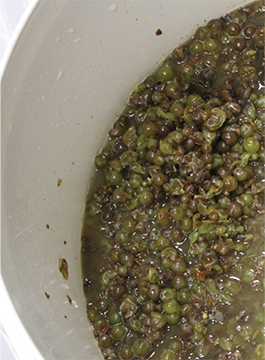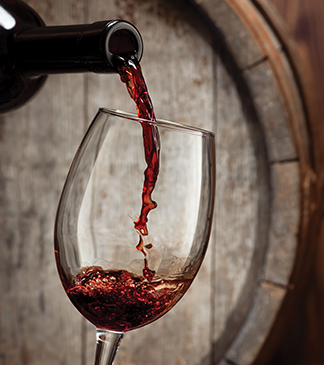
Yeast, like most living things, have a climate that they prefer. Just as people like warm, sunny weather, yeast, too, like their atmosphere temperate. When things get cold, around 40 °F (4 °C), yeast start to shut down. When must gets very warm (around 100 °F/38 °C), things also start to get uncomfortable for the yeast, and undesirable results can occur.
Additionally, fermentation is an active, living process, and all that activity can cause temperatures to rise in your must. Ultimately, this means that to create good wine with the flavors you intend, it is extremely important to control must temperature.
The type of wine you are producing will direct what temperature range is optimum. White wines are generally fermented under cool (not cold) conditions, while red wines can be fermented a little warmer. For a fruity, white wine, cooler temperatures — 40 to 70 °F (4 to 21 °C) — allow for the retention of highly volatile aroma components. A rapid, warm fermentation will create a draft of carbon dioxide rising from the must, taking fruity esters with it. However, red wines stand up much better to elevated temperatures (50 to 80 °F/10 to 27 °C), and extraction of color and tannins may actually be enhanced by it.
As in most cases, there are optimum ranges. There exist formulas for predicting the temperature rise per degree Brix, but there are so many variables involved in fermentation conditions that a formula will usually not be able to truly predict the temperature your must will reach.
The basic math says that your temperature will rise about 1 °F (0.5 °C) for each degree Brix and assumes that around 40 percent of the heat escapes to the surrounding atmosphere. The conditions that most affect this ratio are the size and shape of the fermentation vessel, ambient air temperature, and fermentation speed.
Fermentation speed and temperature are directly related in that the higher the temperature goes, the faster the fermentation will roll. And the faster the fermentation goes, the faster the temperature will rise. If 30 gallons (114 L) of must is left to ferment overnight in a partially insulated container, it can easily reach 100 °F (38 °C) by morning.
While it might at first seem advantageous to have the fermentation finish in just two days or so, consider how this will affect both the activity of the yeast and the flavor of the must. When fermenting at rapid rates, certain strains of yeast can produce hydrogen sulfide (H2S), giving your wine a rotten egg or cooked cabbage smell. This doesn’t always happen, and it might just blow off if it does, but there’s no reason to risk such ill results. The reasons this occurs are not known, and it’s not always possible to predict which strains will produce hydrogen sulfide (though Montrachet is a good bet if you want to get some stinkiness). So it’s best not to gamble. Also, temperatures this high can produce “cooked” flavors in the finished wine. Excessively high temperatures may also be a cause of some stuck fermentations, as the yeast find it difficult to perform when it’s too hot.
Fermentation speed and temperature are directly related in that the higher the temperature goes, the faster the fermentation will roll
On the other side of the coin, if a must is kept too cool, the fermentation will simply stop. The main danger here is that the must is then vulnerable to contamination by organisms that can better tolerate the low temperatures. With the yeast not producing alcohol, bacteria, wild yeasts, and mold can grow.
The lower the temperature, the slower the fermentation will proceed. Molasses-in-January-type fermentations leave the must open to those other organisms and all the “characters” they produce. It’s best to get the fermentation started quickly and then keep it rolling at a nice, even temperature for the duration of the process.
Warming Ways and Cooling Trends
In commercial applications, wine is warmed by its own fermentation activity in an insulated container and cooled by glycol or ammonia jackets. Heat exchangers are used both to warm and cool must, juice, and wine. These same principles can be used at home, but equipment will have to be slightly different (unless you are interested in building an anhydrous liquid ammonia system in your garage).
The first step for red wines is to jump-start fermentation by your desired organism. If you crush and add yeast into insulated containers, the yeast will rapidly build up heat in the liquid. Then, when the must reaches around 80 °F (27 °C), simply transfer it to an uninsulated container, where it will cool. The fermentation will stabilize and should stay at 70 to 80 °F (21 to 27 °C) until the sugar is almost all consumed.
Regular punchdowns, in addition to all their other purposes, will keep the juice under the cap from storing heat.
If the must gets too cool (under 65 °F/18 °C), just put it back in the insulated container. If you have the resources, Rubbermaid Roughneck trash cans, sprayed with foam insulation, work very well. You can also use the same container with some other insulation, such as room-temperature water or blankets. The other nice thing about these cans as fermenters is that they have lids that fit snugly but aren’t completely airtight.
Regular punchdowns, in addition to all their other purposes, will keep the juice under the cap from storing heat. As long as your fermenter is not too big (under 50 gallons/190 L, say) and the must is transferred before it gets too hot, you will not likely have problems with keeping it at the right temperature.
For white wines you’ll see better results if the fermentation proceeds a little slower and at a cooler temperature. Here’s where it gets tricky. The same problems with bacteria and wild yeast exist here, so start the fermentation at room temperature to get it going. Then once it’s rolling, get the must to a cool atmosphere. If your fermenters are small, you can immerse them in water (a bathtub or water trough works well). Cooling the water by running it (not too environmentally friendly), adding ice, or circulating it through a heat exchanger will keep your fermenters at whatever temperature you like.
The key here is to check the must temperature regularly, two or three times a day or so, to make sure the must doesn’t get too warm or too cold. If you happen to have a refrigerator that will keep a constant temperature near 50 °F (10 °C), this is an ideal place to keep fermenting juice. Most refrigerators don’t get that warm but if you’re lucky, you can find one that’s not too efficient or reduce its efficiency by adding jugs of water. An older refrigerator should work just fine. Be careful that your must doesn’t get below 40 °F (4 °C), though, or your yeast will go into hibernation.
If your fermentation is going too slowly or activity ceases, warm it up a little to get it going. If neither of these methods works for you, try freezing milk jugs full of water and floating them in the must, stirring with them, or using them to do your punchdowns (if you’re making red). As long as the liquid is being stirred around (and even probably if it’s not), parts of the must won’t get too cold.
The basic goal is to keep a strong, smooth fermentation going consistently until all of the sugar is consumed. If you can keep red wines around 70 °F (21 °C) and whites at around 55 °F (13 °C), you’ll probably achieve this. Diligent temperature taking and temperature correcting should keep your must at the ideal temperature for the best results.






